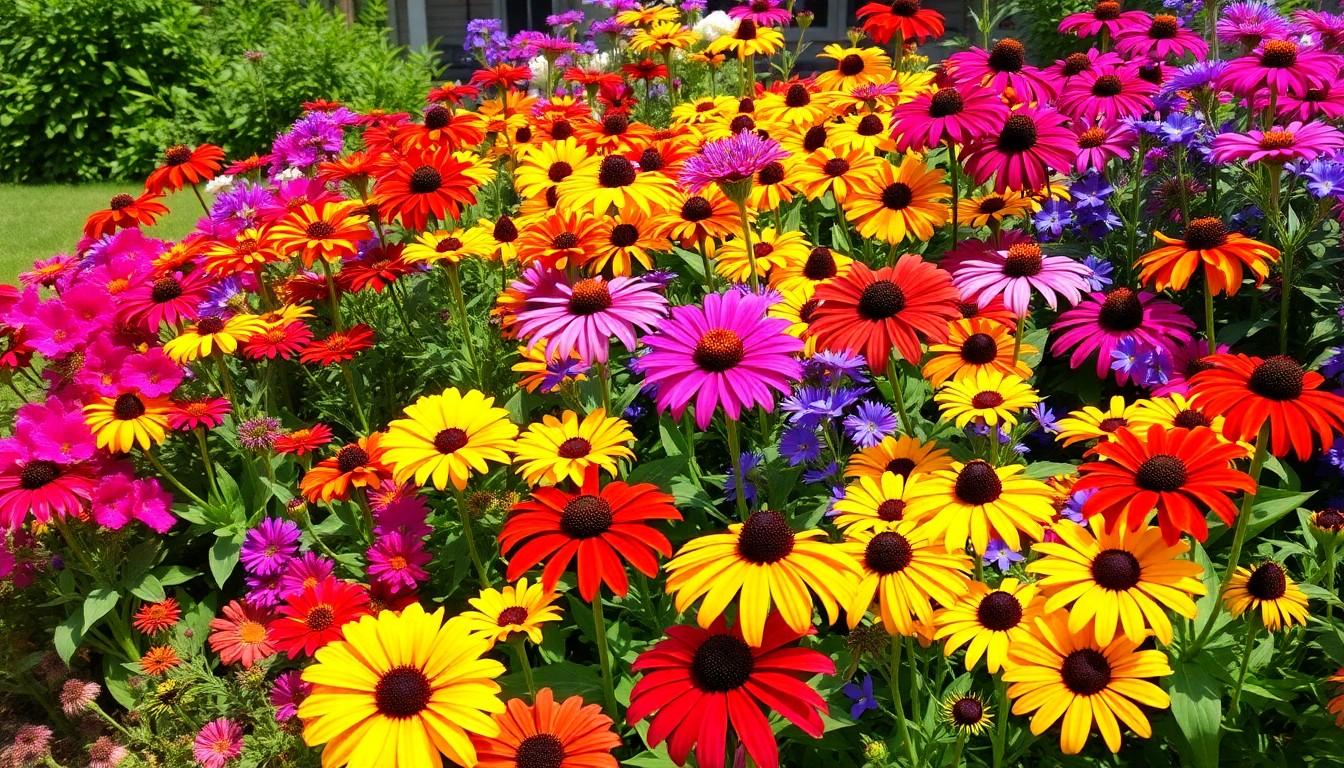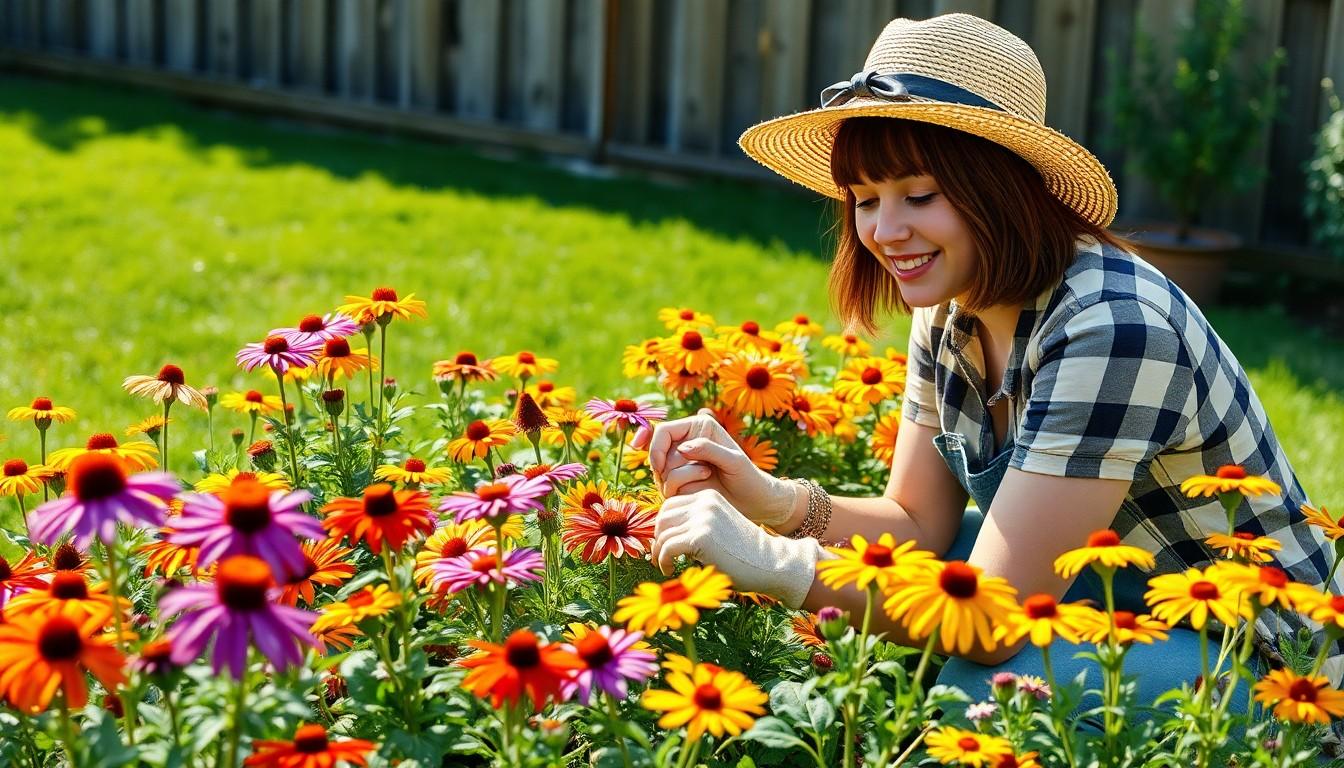Imagine stepping into your garden and being greeted by a riot of colors and scents that make your heart sing. Living spaces flowers can transform any outdoor area into a vibrant sanctuary where nature thrives. Whether it’s a cozy balcony or a sprawling backyard, the right flowers can turn mundane patches of dirt into a floral fiesta.
Living Spaces Flowers for the Garden
Living spaces can significantly benefit from the addition of flowers in the garden. Colorful blooms not only enhance aesthetics but also attract pollinators, enriching biodiversity. Selecting the right flowers ensures a vibrant environment throughout the seasons.
Gardening enthusiasts often choose perennial flowers for their longevity and low maintenance. Popular options include purple coneflowers and daylilies. Annual flowers like petunias and marigolds provide seasonal bursts of color, making them ideal for dynamic garden designs.
Native flowers, such as black-eyed Susans and coreopsis, thrive in local conditions and require less watering. Incorporating these species supports local wildlife and preserves ecological harmony.
Accessibility remains a crucial factor when selecting flowers. Raised garden beds are suitable for those with limited mobility, allowing for easier planting and maintenance. Grouping flowers by height and color creates a visually appealing layout, ensuring all plants receive sufficient sunlight.
Understanding bloom times allows for a garden that remains colorful year-round. Early bloomers like crocuses provide spring cheer, while late bloomers such as asters extend joy into the fall months.
Investing in the right soil treatment and fertilizers can enhance flowering potential. Organic matter enriches soil quality, promoting healthy root systems. Regular deadheading encourages prolonged blooming, ensuring a stunning display.
Creating living spaces filled with flowers enriches outdoor experiences. Whether for serene relaxation or entertaining guests, gardens equipped with colorful blooms transform yards into vibrant retreats.
Types of Living Spaces Flowers

Living spaces benefit from a variety of flowers that enhance their beauty. Selecting the right types ensures vibrant and colorful gardens.
Annuals
Annual flowers provide immediate color and are perfect for seasonal displays. Petunias bloom profusely and adapt well to different conditions. Marigolds resist pests and add bright shades of orange and yellow. Zinnias thrive in full sun and attract butterflies, creating dynamic gardens. These flowers usually require replanting each year, offering fresh opportunities for creativity. Gardens can transform with annuals, providing instant gratification and lively aesthetics.
Perennials
Perennial flowers return each year, making them a practical choice for long-term beauty. Purple coneflowers boast striking purple petals and attract pollinators, enhancing biodiversity. Daylilies come in various colors and require minimal care, adding vibrancy to gardens. Black-eyed Susans thrive in diverse environments and offer cheerful yellow blooms. Selecting perennials creates lasting visual interest while reducing maintenance. These flowers enhance garden longevity while turning spaces into colorful sanctuaries.
Benefits of Incorporating Flowers in Garden Spaces
Incorporating flowers into garden spaces provides numerous benefits, enhancing both aesthetics and the environment.
Aesthetic Appeal
Flowers create vibrant landscapes that capture attention. Various colors and shapes invite visitors, transforming mundane spaces into beautiful retreats. Their blooming seasons offer continuous visual interest throughout the year. Grouping flowers by height and color makes gardens more appealing. For instance, a mix of tall sunflowers paired with low-growing petunias creates a striking contrast. Selecting flowers that complement each other ensures harmony in design. Regularly changing annuals adds freshness to gardens each season. Overall, flowers elevate outdoor spaces, making them aesthetically pleasing.
Ecological Benefits
Flowers significantly contribute to ecological health. Pollinators, such as bees and butterflies, thrive in gardens with diverse blooms. These insects play a critical role in plant reproduction, benefiting local ecosystems. Native flowers attract more wildlife, promoting biodiversity. Additionally, vibrant gardens improve air quality by filtering pollutants. They also help retain soil moisture, preventing erosion. Moreover, gardens create habitats for beneficial insects, which support natural pest control. By incorporating a variety of flowers, gardeners foster a balanced and vibrant ecosystem. These ecological benefits enhance overall garden functionality and wellbeing.
Tips for Choosing the Right Flowers
Choosing the right flowers for a garden involves key considerations.
Climate Considerations
Climate influences flower growth significantly. Recognizing the USDA plant hardiness zone is essential for selecting flowers suited to local temperatures. Warm climates support vibrant sunflowers and zinnias, while cooler areas thrive with asters and peonies. The presence of moisture or drought affects flower choices too. Drought-tolerant varieties like lavender flourish in dry conditions. Additionally, understanding seasonal changes ensures blooms appear at optimal times. Knowing frost dates can protect delicate varieties from unexpected temperatures. Selecting flowers adapted to local climate fosters healthy growth and a flourishing garden.
Space Requirements
Space considerations dictate flower arrangement. Assessing the garden layout helps determine flower placement and variety. Compact flowers like pansies fit well in limited areas, while sprawling plants such as clematis require more room. Grouping tall flowers like sunflowers at the back of borders provides a visually pleasing effect. Flowers with varying heights add depth and interest to beds. Also, considering the mature size of the plants prevents overcrowding, allowing adequate sunlight and airflow. Planning for flower spread ensures gardeners create a cohesive, thriving landscape.
Care and Maintenance of Living Spaces Flowers
Maintaining flowers in living spaces ensures they thrive and provide beauty throughout the growing season. Proper care involves consistent watering, fertilizing, pruning, and deadheading for optimal blooms.
Watering and Fertilizing
Flowers require regular watering to keep soil moist but not soggy. Gardeners should check moisture levels daily during hot months. Fertilizing enhances growth and bloom production. Organic options like compost or well-balanced fertilizers deliver essential nutrients. Timing matters; applying fertilizer at the beginning of the growing season maximizes benefits. Adjust feeding frequency based on flower types, as annuals may need more frequent fertilizer than perennials. Soil testing proves useful, allowing gardeners to tailor nutrient application effectively.
Pruning and Deadheading
Pruning promotes healthier flower growth and shapes plants. Gardeners should assess plants for dead or damaged stems regularly. Deadheading, or removing spent blooms, encourages further flowering and keeps the garden looking tidy. Timing for deadheading varies by flower type, yet frequently checking helps. Proper tools, such as sharp shears, prevent damage to the plants while making clean cuts. Ensuring that perennials are cut back in fall supports vigorous spring growth. Keeping the flowers well-maintained leads to a vibrant and lush garden.
Vibrant Retreat
Transforming outdoor spaces with flowers creates not just beauty but a thriving ecosystem. Selecting the right blooms can turn a simple garden into a vibrant retreat that attracts pollinators and enhances biodiversity.
Whether opting for perennials or annuals gardeners can enjoy a colorful display that evolves with the seasons. By considering local climate and space requirements it’s possible to create a flourishing environment tailored to individual needs.
With proper care and maintenance flowers will thrive, bringing joy and serenity to any living space. Embracing the art of gardening with flowers not only enriches personal spaces but also contributes positively to the environment.

